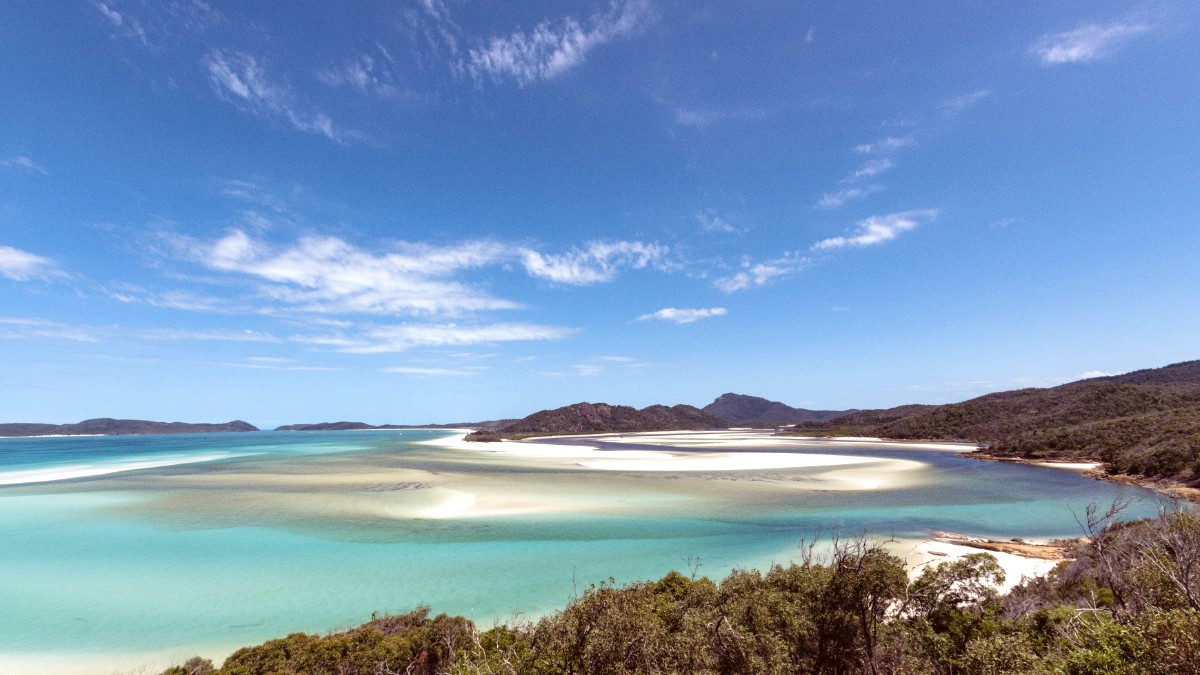
Queensland, Australia
The allure of the Whitsundays lies in its natural splendor and the array of experiences it offers. You can spend days exploring uninhabited islands, hiking to panoramic lookouts, or simply relaxing on pristine beaches. The marine environment presents opportunities for close encounters with turtles, dolphins, and a spectrum of fish. Each day in the Whitsundays presents a chance for discovery, whether it involves a thrilling adventure or quiet contemplation of the natural world.
The Whitsunday Islands draw travelers from across the globe, eager to witness their beauty. Many come to experience the world-renowned Whitehaven Beach, with its unique silica sand. Others seek the quiet thrill of sailing through protected waters, dropping anchor in secluded bays. Divers and snorkelers explore the fringes of the Great Barrier Reef, an underwater spectacle of immense scale and beauty. From the lively mainland hub of Airlie Beach to the luxurious private island resorts, the Whitsundays includes varied experiences. This guide details these choices.
Beyond the breathtaking scenery, the Whitsundays has a relaxed, welcoming atmosphere. The pace of life slows here, inviting you to unwind and embrace the tranquility of island living. The region acts as a gateway to the larger Great Barrier Reef, making it a prime location for experiencing this natural wonder. As you plan your visit, notice that the Whitsundays is more than just a destination; it is an immersive experience, a chance to connect with nature, and a setting for creating lasting memories.
The Whitsundays' location within the Great Barrier Reef provides its unique ecosystem. The islands act as a protective barrier, creating calm inner passages ideal for sailing and water sports. The mainland town of Airlie Beach serves as the main gateway, positioned strategically to offer easy access to the islands by boat. Other coastal towns, like Proserpine (home to the Whitsunday Coast Airport) and Bowen further north, support the region.
The geological formation of the Whitsundays is a result of ancient volcanic activity and rising sea levels. The islands are predominantly continental, meaning they were once part of the mainland. Over millennia, erosion and ocean currents shaped them into their present forms. The famous white sand of Whitehaven Beach, composed of 98% pure silica, represents a remarkable geological feature, unlike typical beach sand. This composition gives it an unique feel and prevents it from retaining heat, making it comfortable to walk on even on hot days.
A main thoroughfare for boat traffic with protected sailing conditions.
Short travel times between stunning locations for varied itineraries.
Dense rainforests, mangrove systems, and unique marine life habitats.
Islands were once part of the mainland, shaped by millennia of natural forces.
Whitehaven Beach's 98% pure silica sand feels unique and stays cool.
The Whitsunday Islands sit off the coast of Queensland, Australia, nestled within the calm, protected waters of the Great Barrier Reef Marine Park. This archipelago comprises 74 islands, with Whitsunday Island being the largest. Most of these islands remain uninhabited, preserving their natural state as part of the Whitsunday Islands National Park. The islands stretch across a vast area, offering numerous bays, inlets, and anchorages.
The mainland town of Airlie Beach serves as the main gateway, positioned strategically to offer easy access to the islands by boat. Other coastal towns, like Proserpine (home to the Whitsunday Coast Airport) and Bowen further north, support the region.
The Whitsunday Passage, a channel separating the mainland from the majority of the islands, is the main thoroughfare for boat traffic. This passage presents protected sailing conditions, making the Whitsundays a popular bareboating (self-skippered yacht charter) destination. The proximity of the islands to one another means short travel times between stunning locations, allowing for varied itineraries.
Plan your island excursions from Airlie Beach. Its central location makes it a practical base for accessing various boat tours and island ferries.
The history of the Whitsunday Islands stretches back tens of thousands of years, rooted deeply in the ancient culture of the Ngaro people. Archaeological evidence, including shell middens and rock art, shows their long presence in the region. The Ngaro people were skilled navigators, using canoes to traverse the waters between islands for hunting, fishing, and gathering. Their cultural sites, like the rock engravings on South Molle Island, present glimpses into their traditions and connection to the land and sea.
European contact began in 1770 when Captain James Cook sailed through the passage on Whit Sunday, naming the area in honor of the day. Early European activity focused around whaling, timber cutting, and later, pastoral leases. The mainland area developed with the establishment of sugar cane and pineapple farming, creating townships like Proserpine. Tourism began to emerge in the early 20th century, with the first resorts appearing on some islands.
Tens of thousands of years of Ngaro people's culture and presence.
Captain Cook's naming in 1770, followed by whaling and farming.
Establishment of Great Barrier Reef Marine Park in the 1970s.
The 1930s marked a turning point with the growth of island resorts, attracting visitors seeking tropical holidays. Hamilton Island, in particular, underwent significant development in the late 20th century, transforming into a major tourism hub with an airport capable of handling jet aircraft. The establishment of the Great Barrier Reef Marine Park in the 1970s and the designation of many islands as National Parks highlighted the region's natural importance and the need for conservation. This protection preserves the delicate ecosystem for future generations.
Mostly uninhabited National Parks; Hamilton, Daydream, Hayman are major resort islands.
Airlie Beach on the mainland for tours and ferries.
Whitsunday Coast Airport (PPP) and Hamilton Island Airport (HTI).
Off the central coast of Queensland, Australia, within the Great Barrier Reef.
Tropical, with a warm dry season and a hot, humid wet season.
Sailing, snorkeling, diving, hiking, jet skiing, paddleboarding, swimming, wildlife spotting.